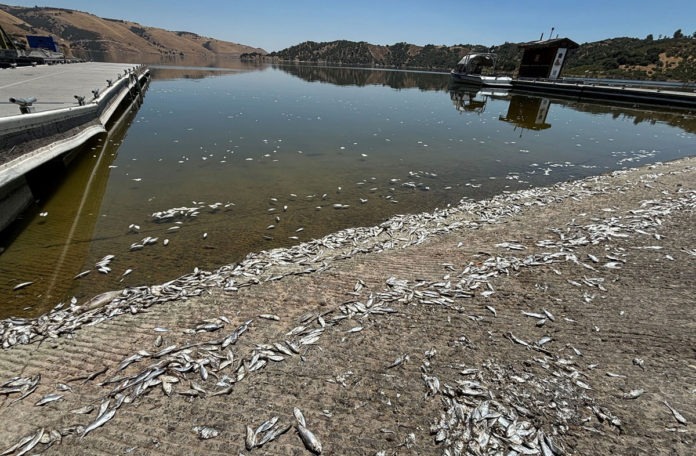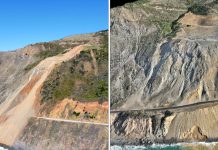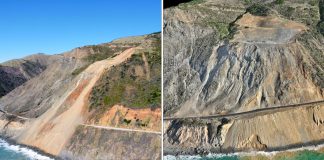
BRADLEY — County of Monterey Parks and Lakes Division, Environmental Health Bureau and Water Resources Agency staff reported Monday that data and testing results from water samples taken in the wake of a massive fish die-off at Lake San Antonio were “inconclusive,” but that a possible cause of the incident could be due to a natural algae phenomenon spurred on by high heat, which lowered the dissolved oxygen concentrations causing the fish to suffocate.
“At this point in time, those conditions have stabilized,” stated the County in a news release.
Parks staff has been busy cleaning up the fish remains, while the Health Bureau — which placed a precautionary measure directive to restrict access to the water, leading to the facility’s closure — has now lifted that measure, with the County planning to reopen the lake on Wednesday, July 24.
On July 5, Parks staff noticed that dead baitfish — mostly shad (a small fish species) — began washing up on the shore. The die-off continued to grow, and in an abundance of caution, the County decided to close Lake San Antonio on July 10, until the situation was researched and better understood.
The die-off appeared to last until July 12, as reported by Parks staff and a California Department of Fish and Wildlife (CDFW) biologist.
“This die-off appears to be the largest fish die-off in Lake San Antonio history,” the County stated.
Determining a cause
“Based on the testing analysis and lack of conclusive evidence, the definitive reason for the fish die-off cannot be specifically determined,” the County explained. “However, due to the fact that mammals and birds, such as wild pigs and turkey vultures, which consumed the dead fish did not die, that satellite imagery indicated the presence of an algae bloom, and water quality testing shows that the lake is normal for a surface water body, the prevailing belief is that dissolved oxygen levels in the water were low enough that the fish suffocated during the recent high heat wave event.”
As the algal bloom diminished, dissolved oxygen concentrations improved, and the fish die-off ceased.
During periods of high heat, algae growth can dramatically increase, which can lower the dissolved oxygen levels in the water. Prior to and through the duration of the fish die-off, temperatures at Lake San Antonio were well above 100 degrees Fahrenheit, warming the water in some areas of the lake to near 90 degrees Fahrenheit, spurring on a “rampant but short-lived algal bloom,” according to the County.
“While the definitive cause of the Lake San Antonio fish die-off is not able to be conclusively determined, based on the test data, we can affirmatively state that it was not caused by bacteria, toxins or pollutants, which could pose a risk to human health,” stated Chief of Parks Bryan Flores. “Algal blooms are part of the biological process in bodies of water, unfortunately at times, they can be impactful on the environment. Parks recommends that while the public is enjoying the lake, to use their best judgement, heed any cautionary signage that may be present and be aware of their surroundings.”
Nearly all test results came back in the normal or non-detect range. Testing and sampling regimen included the following:
- Water Resources Agency took readings for water temperature, conductivity and dissolved oxygen;
- Environmental Health Bureau conducted bacterial, heavy metal and toxin sampling; and
- CDFW took daily temperature and dissolved oxygen readings and sampled for the presence of algae, cyanobacterial toxins (microcystins/nodularins, cylindrospermopsins, anatoxins and saxitoxins) and golden algae.
“Staff thanks the public and the Board for their patience and understanding through this event and looks forward to the return of recreation at the lake,” stated the County.













